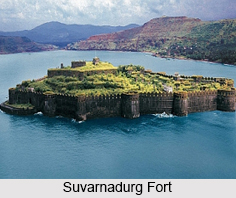 Suvarnadurg Fort is an island fort situated in the Ratnagiri District of Maharashtra. The fort is located on a small island in the Arabian Sea, along the West Coast of India. The fort also includes another small land fort called the "Kanakadurga Fort" at the base of headland of Harnai port on the coast. The basic objective of establishing the fort was to counter enemy attacks, mainly by the colonialists of Europe and also by the local chieftains.
Suvarnadurg Fort is an island fort situated in the Ratnagiri District of Maharashtra. The fort is located on a small island in the Arabian Sea, along the West Coast of India. The fort also includes another small land fort called the "Kanakadurga Fort" at the base of headland of Harnai port on the coast. The basic objective of establishing the fort was to counter enemy attacks, mainly by the colonialists of Europe and also by the local chieftains.
Etymology of Suvarnadurg Fort
The literal meaning of Suvarnadurg is “Golden Fort†as it was considered as the pride or the "feather in the golden cap of Marathas". Built for the Maratha Navy for defence purposes, the fort also had a ship-building facility.
History of Suvarnadurg Fort
Suvarnadurg Fort is believed to have been built by the Bijapur kings in the 17th century. It was soon captured by Chatrapati Shivaji Maharaj in 1660 by defeating Ali Adil Shah II. Kanhoji Angre, popularly known as “Samudratla Shivaji†was the Koli Admiral of the Maratha Navy; in 1696, Kanhoji"s naval fleet was stationed here. However, the fort was formally handed over to Kanhoji in 1713 by Shahu Raja. In 1755, the British attacked and took control of the fort and formally handed it over to the Peshwas. The fort was thus under the control of the Peshwas till 1818. In 1818, Captain William of the British army attacked the fort and took full control of it.
 Structure of Suvarnadurg Fort
Structure of Suvarnadurg Fort
Suvarnadurg Fort is spread over an area of 8 acres and is about 1 mile from the main land. It is encircled by a dry moat. It tapers towards the southern direction from where the Kanakadurga fort is clearly visible. The walls of the fort have been mostly cut out of the rock and some part of the fort walls are built with large stone blocks. There are two gates known as the "Maha Darwaza" on the east and "Chor Darwaza" on the west. The Maha Darwaza faces the land and the Chor Darwaza faces the sea. The main east gate is blocked by thorny bushes and has a carving of Lord Hanuman on the wall. The sea-gate depicts carved figures of a tiger, eagle and elephant. The fort is fortified with many bastions, which also have small built-in rooms. The central part of the fort has two granaries and a decrepit building. 15 old guns have also been located in the fort. There are several potable water sources and a step well in the fort.
Visiting Information of Suvarnadurg Fort
The nearest railway station to reach Suvarnadurg Fort is on the Konkan Railway and the nearest airport is at Mumbai. Mumbai is at a distance of 230 kilometres from Harnai. The only approach to the fort is by boats, from Harnai. Boats have to be arranged through the local fishermen.



















